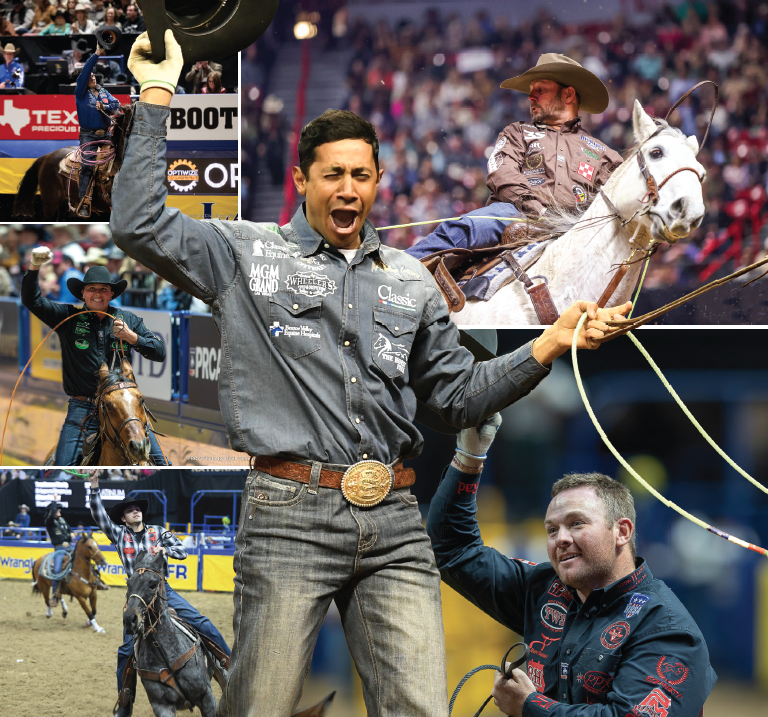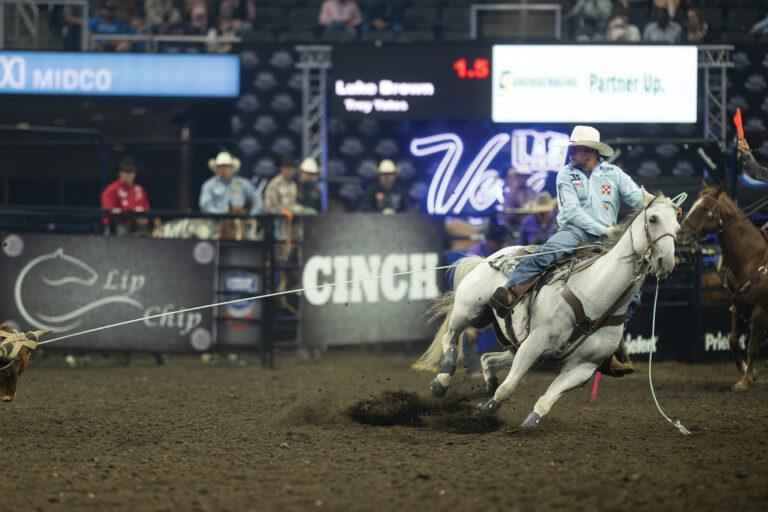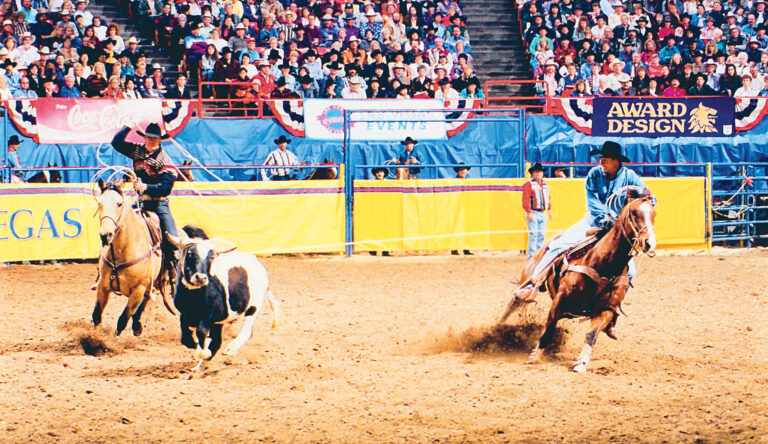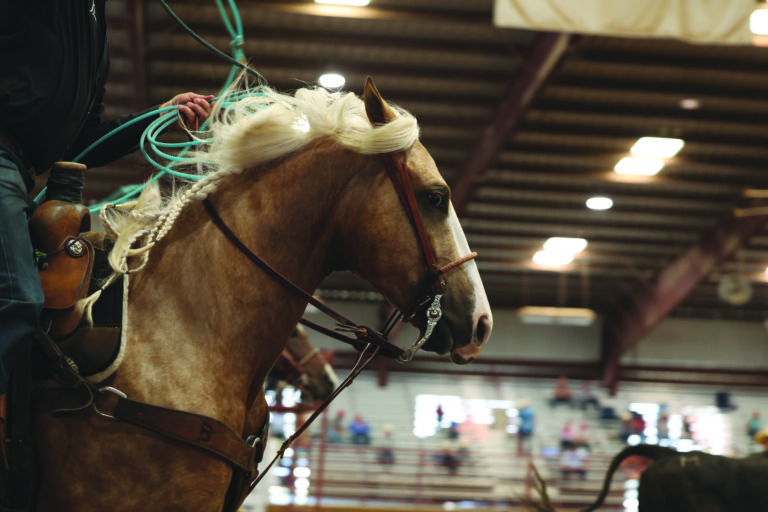What makes a horse that can make a lower-numbered heeler’s job fun and easy?
From the time a header calls for a steer to when the heeler grabs his wraps and pulls back, there’s a lot happening in a fairly short amount of time. For the heeler, he must ride his horse down the arena, negotiating his position on the corner, get a loop under the feet and get to the saddle horn.
While the pros make all these steps look effortless, for a lower-numbered heeler, it’s a lot to think about and he’ll need a horse that gets him to the right place during each step of the process.
What does that unicorn look like?
Top trainer Cade Rice, who piloted Sevens Star Glo to the 2022 American Rope Horse Futurity Association World title in heeling, and PRCA World Champion Header Matt Sherwood, who has more than his share of winnings on the back side, weigh in on the top characteristics of heel horses for low-numbered ropers along with a couple of ropers who fall into that category: Arizona’s Nasia Chapman and California’s Freddie Hice.
WATCH: Heeling Horsemanship video library on Roping.com
1. Gentle
Though enough training can take a horse of any disposition to a successful career, Rice says hotter horses are not usually ideal.
“The hottest horses usually just don’t make for lower-numbered ropers,” he said. “There’s maybe a few exceptions but the more laid back, just chill, do-whatever-type of horse you can get, those make a better fit.”
“I don’t think they need a horse with a lot of speed, maybe an older horse that has lost a step but is super solid and consistent,” Sherwood said. “If you’ve got one with fast feet like a pro-level guy would want, that he can place where he wants him, that’s going to be too much action for a lower-numbered heeler.”
A low-key disposition can often go hand in hand with gentleness and both are important for ropers not as proficient with handling their rope and negotiating the horse’s position all at once, keeping the roper and those around him safer during his practice and competition.
2. Broke
Further complicating things, many low-numbered ropers work regular jobs, leaving little time to ride and practice during the working week. Though Chapman enjoys working with and training her own horses, she also works in law enforcement and understands the challenge of trying to balance roping with regular employment.
“Most of these guys are working 40, 50 hours a week,” Chapman notes. “They’re not like the pro guys who rope every day so they need something that can sit for a week or two and then be the same horse when they pull him out to go rope.”
“I went to the police academy for six months,” Chapman continued, noting her horses stood during that time period. “The weekend after I graduated, I went to a jackpot and won pretty good. My horses didn’t even break a sweat because they are broke and solid and know how to take care of themselves.”
3. Seasoned and honest
Along with a gentle, broke horse, low-numbered ropers set themselves up for success when they choose a horse that has been down the road and knows his job and is not going to cheat along the way.
“You want a horse that’s honest and is going to give you the same shot every time. Whether it’s fast cattle, slow cattle, the Heel-o-matic, whatever,” Chapman said.
“If you’re jackpotting, you don’t want one that’s going to get short on you after you’ve roped two or three.”
Hice used to head professionally in California but his three-plus decades in the movie business hasn’t left much time for roping; he performed stunts and worked as a stunt coordinator on major films from Cowboys and Aliens to Matrix Reloaded and a couple installments in the Fast & Furious series among many others but is now in semi-retirement and looking forward to more time in the roping pen.
“I’m 69 years old and the horse I just bought, he does it all,” Hice joked, noting the importance of a gentle and solid mount. “In fact, when I do things wrong, he actually tries to correct it for me.”
4. Just the right age

Our experts and our ropers agree that lower-numbered heelers should be seeking out middle-aged horses who’ve had the time to develop the needed experience.
“You want an older horse, maybe 12- to 15-years old who has been there and done that,” Hice noted.
“They definitely should go for the older, more seasoned horses,” Rice agreed. As a trainer, Rice notes the time it takes to get a horse solid and consistent, traits that are critical for ropers with a lower skill set.
“I want them light in the bridle and we track, track, track,” he said. “That’s how you get the horse to time the cow up, heading or heeling, and just get to the spot and stay there. It takes years.”
“Everyone loves the idea of buying a young horse and watching him come along but it’s a very long, hard process and they need tons of experience and training,” Sherwood added. “And not just anyone can step on and train a heel horse.”
“Let’s be honest, a horse can keep going until he’s 25 if you take care of him and especially for lowerer-numbered guys, they’re not using them into the ground,” Chapman said. “Plus, the older horses are smarter and know how to take care of themselves.”
5. Good in the box
While a good deal of emphasis is placed on the box work for head horses, given the need to read the barrier correctly, a horse that is good in the box is just as important for the guy on the back half of the team roping equation.
“He needs to be solid in the box,” Rice said. “The horse has got to let the roper adjust himself in the box to be prepared for the run.”
“The horse needs to score good,” Hice agreed. “He should be bomb-proof in there. You can’t have one spinning off the corner just as your header is nodding and then you’re behind.”
As someone who works both ends, Hice recognizes the value of having a heeler who can haze a cow, something else that requires a heel horse who will stand in the box and roll out on cue. Hazing to help keep a steer straight is useful when roping with fellow low-numbered headers who may have more trouble chasing one down off to the right.
“Great heel horses make great hazing horses,” he laughed. Most of his rope horses in the past few years have transitioned to steer wrestling for his son, Ronan. “Watch the best heelers out there, guys like Allen Bach and Jade Corkill, they get out there and haze almost like the steer wrestling.”
6. Reading cattle
Setting up your shot with a good corner may not be as critical when roping in lower-numbered ropings as it is for open and rodeo runs, but a correct corner is still a very important piece of being able to catch two feet.
“The problem I see with a lot of low-numbered ropers is that they cut the corner too much and get way too far inside and then it takes them a long time to get to position to throw,” Sherwood said. “Their horses aren’t staying out and coming in behind the steer.”
Basically, the horse needs to read the cow on the turn and be able to find position with little help from his jockey.
“The horse can’t over run or under-run the cow down the pen,” Rice said.
As Chapman puts it, “if you’re having to pull, you’re done.”

7. Patience and tracking
When the corner is made, there’s usually much more work to be done with a lower-numbered heeler who isn’t going to pull the trigger right there on the corner.
“The horse needs to track the cow. He has to let a guy have a chance to rope,” Rice said.
“For me, a horse needs to be more free but not so much that I’m pulling on him,” Chapman said. “When you’re pulling on your horse, it pulls you down in your saddle and messes up the angle on your loop.”
“I think for a lot of lower-numbered ropers, they have a lot of issues if they have to pull too much or if they have to kick too much,” she said. “You need that perfect in-between.”
Sherwood agreed there’s a sweet spot when tracking and roping and having a patient horse is critical for lower-numbered heelers.
“You don’t want something that’s trying to stop and taking the throw away,” he said. “The horse needs to be waiting for the roper to make the commitment to throw. He has to give the roper time to make the delivery of his loop and if the horse is stopping too abruptly, it doesn’t allow time for the loop to develop.”
8. Just enough whoa
At the same time, the horse must be ready to stop when the roper has made the commitment to throw. A horse that doesn’t stop when the loop is thrown is just as difficult as one that stops too soon.
“The horse has to want to stop,” Sherwood added. “If he keeps going when the roper throws, it’s really difficult to get that bottom strand down on the ground.”
9. Smooth and strong
When the roper has delivered his loop and—hopefully—tangled up some feet, the heeler must be ready to dally and his horse must hold tight while the header faces (unless you’re at a roping that flags on the heels).
A horse that stops smoothly can aid in the dallying process.
“My sorrel dials in there and is honest and when I rope, he leaves the horn up there where I could dally all day if I wanted to dally,” Chapman joked. “Then, once he sets down, he’s strong and pulls everything back because sometimes in the lower numbered ropings, your headers have some trouble facing.”
A smooth horse is a plus too, just because he makes it easier to ride out of the box and around the corner.
“You see a lot of guys getting bounced around leaving the box and that just makes it harder,” Chapman said.
10. Good manners
Looks and breeding are nice to have, if they are wrapped around a package that has the other needed attributes, but any horse in the hands of lower-skilled ropers needs to be easy to handle.
“An older horse that is solid and seasoned is going to come with a higher price and it’s completely worth it,” Chapman said. “You want something that’s been hauled, that can sit and then go hard and you can take to the jackpots and there’s no issues, he eats and drinks, doesn’t paw or tear up your trailer.” TRJ









